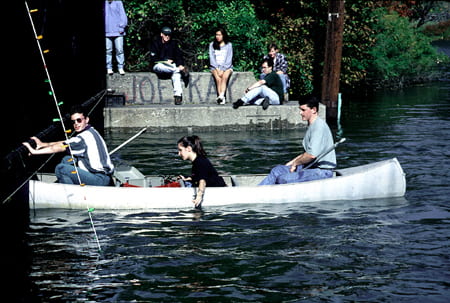
This walkway looks from Constitution Marsh into the throat of the Hudson Highlands. Students began their work by canoeing, from the Constitution Marsh Audubon Nature Center down Phillips Creek into South Cove, and then into Foundry Cove.

Foundry Cove is located near Cold Spring, New York, and was a receptacle for cadmium waste for over 20 years. A SuperFund restoration project cleaned up the cadmium-laden sediment. Students in the course were the first to measure the degree and success of the cleanup.

The marsh is dissected by channels that allowed us to canoe easily between the relatively clean South Cove and the polluted Foundry Cove.

We measured water flow at the bridge using a current meter and also sampled water, in order to measure current cadmium exchange with the Hudson. We found that cadmium was a tenth the concentration on particles, relative to before the cleanup. This meant that much less cadmium was leaving the cove than before.

All sampling was done with the aid of canoes, supplied by the Constitution Marsh sanctuary.

We collected sediment and animals by scooping mud over the side, and also by the use of quantitative sediment samplers.

Sediment was sieved and animals were collected and counted. We found that there were a fairly large number of new species that had invaded Foundry Cove, but were rare in South Cove, which was not dredged out. The Foundry Cove fauna now included a number of bivalve mollusks.
The marsh area in Foundry Cove was restored by replanding seedlings, that had been transplanted from hothouses. In general the regrowth has been successful, although Canada geese have eaten many of the plants.
We hope that muskrats will reinvade the marsh. They had been formerly uncommon, which seems related to cadmium poisoning.

These are the towers used to process dredged cadmium-laden sediment from the Cove.

Here we see the newly planted marsh. Plants grew well, although Canada geese grazed on new shoots heavily in some places.
